According to Mr Magni Arge, CEO and President,
“Atlantic Airways vision is to build bridges in the air between the
Faroe Islands and the rest of the world.”
As the Faroe Islands broke away from Danish rule, it has become more
important for these remote islands to gain more access to the rest of
the world in order to survive in the modern day of business. Yet it
has also meant that these scattered islands also needed to become more
easily connected. This is a promise that the newly elected Faroese Government
had made to the Faroese people and Atlantic Airways plays an important
role in this promise.

|
Not many people are
aware of the existence of the Faroe Islands, which means
“Sheep Islands.” With some 70,000 sheep and a population of
around 48,000, I suppose that this is a fitting name. The Faroe’s
started as home for Irish hermits who were replaced by Vikings.
The Faroe Islands are a self-governing (Hjemmestyre) territory
within the Sovereignty of Denmark. Situated halfway between
Scotland and Iceland in the North East Atlantic, this group
of 18 mountainous islands has a climate much the same as Northern
Scotland. The chief export is fish and associated products.
Right: The Faroe Islands
Photo © Paul Dubois
|
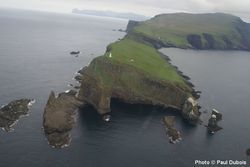
|

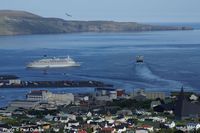
|
Thus, shipping has
a major role with most goods being transported by sea. However,
over the last 20 years, major investments have been made in
modernising the transport infrastructure, with much improved
roads which include tunnels connecting some islands.
Left: Torshavn, capital
of the Faroe Islands.
Photo © Paul Dubois
|
Vagar Airport, is the hub for
about 12 helicopter pads around the islands, which reduced the reliance
on the sea.
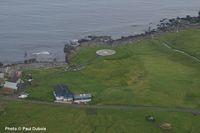
A typical Helipad showing terminal,
wind sock and awaiting PAX. |
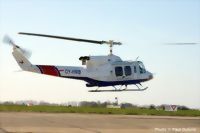
Bell 212 OY-HMB - Norwich Airport, UK.
|
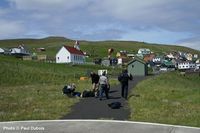
PAX disembark. Note Terminal
and wind sock.
|

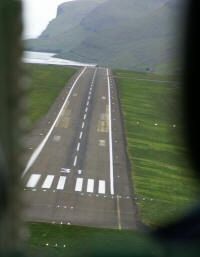 |
The Faroe Islands only have one airport
which was built during 1941 by British Army Engineers, for the
use by allies during World War II. During the early 1960’s,
the airport was modernised for civilian aircraft and on the
1st July 1963, it was opened to civilian traffic.
Due to the short runway, only short take off and landing capable
aircraft are used. It is one of the toughest airports to operate
from and frequently closes due to bad weather and wind shear
which can have a diverse affect on aircraft approaches.
Left: The approach to runway 31 shows the hazards faced
when operating from Vagar Airport.
Photos © Paul Dubois |
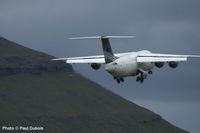
Ex Faroejet BAe-146, OY-FJE now operated by Atlantic Airways
taking off from Vagar Airport. Shows the difficult operating
conditions faced by the crew.
|
Vagar airport remained
under the control of Danish Civil Aviation Authority from 1963 until
30th April, 2007. On the 1st of May, 2007, the Faroese Government took
over control of the airport which is run by the Ministry of Trade and
Industry. Since 1977, jet aircraft have operated to Vagar Airport using
the 1250m Asphalt (13/31) runway and they have plans to increase this
to 1650 m in the future. Plans also exist to expand the apron and terminal.
At the moment these plans are under legislation and further specifications
are expected to be announced this year. During 2003 the airport handled
162 917 passengers and for 2007 they handled 219 329 passengers which
was an increase of 11075 passengers from the previous year. This is
an increase of 5,3% passengers compared to the previous year. (2006).
Vagar has around 3000 inhabitants, so with about 200 employees, the
airport has significant economic benefits for the island. For many years
Maersk Air operated to the Faroe Islands unchallenged as the sole operator
until early 1980’s when the Faroese Government decided that they should
have their own airline. During November 1987, they formed Atlantic Airways
together with a Danish company Cimber Air.
Atlantic Airways
had a difficult beginning from the time that the Danish authorities
issued a license for a local Faroese operation in 1976. Due to the lack
of experience in aviation, Atlantic Airways only became a reality in
1987 with a single BAe 146, OY-CRG. The first commercial flight was
to Copenhagen, on 28th March 1988. During 1989 they carried 43 000 passengers.
Over the years Atlantic Airways suffered many financial hardships until
1995, when Atlantic Airways realized its first profits. Over the last
twelve consecutive years the airline has made a profit . Last year Atlantic
Airways flew 11000 hours and this trend is expected to continue during
2008 when 18 000 hours are estimated to be flown. During 2007 they flew
360 000 passengers and 900 tons of freight, with an estimate of 500
000 passengers and 1000 tons of freight for 2008. Places they fly to
are; Narsarsua (Greenland), Reykjavik (Iceland), Stavanger (Norway),
Stockholm (Sweden), Aalborg, Billund, Copenhagen (Denmark), Shetland,
Stansted, and Aberdeen. (UK). Copenhagen is the busiest route with up
to six flights a day, followed by Billund with up to 9 weekly flights.
The rest vary from 2 to 4 flights a week.
Atlantic Airways
is the only carrier to offer a direct service from London (Stansted)
to the Shetlands. Destinations such as Aberdeen, Oslo, London, Aalborg
are only operated during the summer months. Atlantic Airways also operates
charter flights which can range from package holidays such as those
done for SkiTravel, or for oil and shipping companies doing crew changes,
construction workers, such as Aker Stord or even Bill Clintons recent
tour of Europe.
Unfortunately on
the 10th October 2006 they suffered the tragic loss of Flight RC 670,
a BAe 146-200A, OY-CRG at Stord Airport , Norway. This occurred when
the aircraft overran the runway, with the loss of three passengers and
one crew member.
|
They also received direct competition
from local start up carrier Faroejet who operated a single Avro
RJ-100 (OY-FJE), but they went bankrupt on the 18th January
2007, which was a blessing in disguise since it enabled Atlantic
Airways to take over the leasing contract of the RJ-100.
Right:
Ex Faroejet Avro RH-100 OY-FJE
Photo © Paul Dubois
|
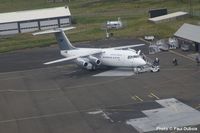
|

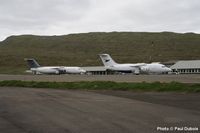 |
Left:
Vagar Airport 2007 with two Atlantic Airways BAe 146’s.
Note the Grey tail and engine covers on the leased aircraft
which was the colours for Faroejet before it ceased operations
and Atlantic Airways took over the lease.
Photos © Paul Dubois
|
Today, the fleet has grown to:-
| 3 BAe 146-200 |
OY- RCA received 2000, OY- RCB received
2004, OY- RCW received 2005. |
| 2 AVRO RJ100 |
OY- RCC received 2005, OY- FJE received
2007. |
| 2 AVRO RJ85 |
OY- RCD received 2007, OY- RCE received
2007. |
| 1 BELL 212 |
OY- HMB used at the start of operations
and subsequently joined the fleet in 1994. |
| 1 BELL 412 HP |
OY- HSJ received 2007. |
| 1 BELL 412 EP |
OY- HSR received 2001. |
| 1 AW139 (On order) |
expected March 2008. |

With the planned
extension of Vagar’s runway, Atlantic Airways will be able to consider
larger aircraft such as the A319, B737-700 and Embraer 195 for it’s
future fleet.
During the period from 19-27 November 2007 Atlantic Airways made it’s
first move towards privatisation with the sale of 33% of the company
to the private sector and on 10 December 2007 they were admitted to
the OMX Nordic Exchange, the 37th company to do so.
As already mentioned,
the Faroe Islands only has one airport so all domestic flights are carried
out by helicopter which probably makes Atlantic Airways unique in this
regard.
During the 1960’s
the Danish Navy patrolled the waters around the Faroe Islands and from
time to time the helicopters on board these ships undertook various
tasks for the civilians located at remote locations. It soon became
obvious what a vital role the helicopter would have for remote areas
that for centuries were only reachable by sea and which during the winter
months would be totally isolated.
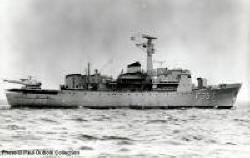 |
During 1982, one of these navy pilots,
Captain Kurt Johansen, then flying with Maersk Helicopters was
approached by the Faroese Government with a view to setting
up a domestic helicopter service connecting the various islands.
Since one of the newly elected Faroese Government election promises
was to improve connections between the various islands. Captain
Johansen had spent several years with the Danish Navy around
Faroese waters, based on the Danish Frigates with an Alouette
III helicopter during fishery protection, SAR and slinging operations.
Left: Danish Frigate “INGOLF” with
Alouette III helicopter, seen in 1963.
Photo © Paul Dubois Collection
|
It was
decided to lease one of Maersk Helicopters Bell 212’s for this
operation. A few weeks before these domestic flights could start,
Capt Johansen went to the Faroe Islands for discussions with
the new head of Government and the Minister of Transport.
They pledged their full support for the initial survey of suitable
helipad locations. A local vessel “TJALDUR” was made
available for this purpose. After a few days they had only covered
the northern most islands due to rough sea’s. After some high
level discussions, the Danish Navy reluctantly provided one
of their brand new Lynx helicopters in order to complete this
task. |
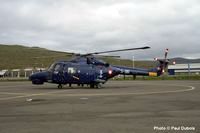
Danish Navy Lynx helicopter
seen at Vagar Airport 2007. |
| The following
week the Ground Operations Manager, Mr Ole Romer, set up the
logistics of the operation and employed a Heliport Manager for
each island. He also bought 15 scales, established a communications
network and weather service for each island. The fire services
garage at Vagar Airport was used as a base and hangar. Two days
before start of operations, Capt Jorgen Pedersen & Capt Johansen
arrived with a Bell 212, OY- HMB, which is still serving Atlantic
Helicopters faithfully today. The day before the operation started
they departed Vagar Airport with a DCAA inspector and the Minister
of Transport, together with orange painted tiles and windsocks.
At each location, seven tiles were off loaded, 3 on each sides
and one in the centre to form a “H” and a broomstick was set
up with a small wind sock, thus creating the first helipads!
|
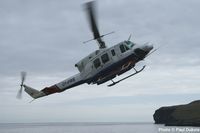
Bell 212 OY-HMB which has
served since the beginning
of Atlantic Airways. |
After three months,
Capt Jorgen Pedersen took over as Base Captain until a year later, when
Faroese pilots took over the operations for another year on behalf of
the Government owned ferry company “Strandfaraskip Landsins.” During
this period, they operated two Bell 212’s, sadly one was lost on 17th
December, 1992 in the Southern Bay of Klaksvik with the loss of all
on board.
This era ended
on the 28th March, 1994 when Atlantic Airways took over operations.
Today, it is known as Atlantic Helicopters but is exactly the same company
falling under Atlantic Airways and still Government owned. Atlantic
Helicopters operates three helicopters with a fourth due for delivery
in March, 2008.
| The fleet
consists of one Bell 212, OY-HMB (SN 30686) built in 1974, which
is an extremely reliable machine and has been giving outstanding
service since the first operations began. The main purpose of
this aircraft is for the schedule operations which are carried
out on Sunday, Wednesday and Friday. Places flown to are; Klaksvik,
Skuvoy, Frooba, Torshavn, Kirkja, Svinoy, Koltur, Dimun, Hattarvik
and Mykines. Underslung operations and ad hoc charters are usually
carried out on the other days. During 2007 Atlantic Helicopters
carried 9400 passengers and it is expected that this figure
will rise to 18000 during 2008. This is the real workhorse of
the fleet which has recently completed a wet lease with Bristow
Helicopters in Norwich UK, flying for ATP, doing off shore work.
Both OY-HMB and OY-HSR carried out this wet lease to Bristow
Helicopters at various periods from March until September 2007.
The serviceability record of OY- HMB is truly outstanding and
is a credit to those who maintain and operate her. |
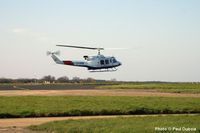
Bell 212 OY-HMB
Photo © Paul Dubois |
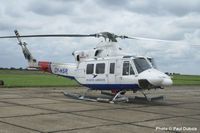 |
Atlantic Helicopters operate one Bell
412 EP, OY-HSR (SN 36133) built in 1996. This helicopter is
the main Search and Rescue machine but has also been used as
back up for the Bell 212. This helicopter was also used for
a period as a wet lease to Bristow Helicopters. The helicopter
is equipped with EFIS, FLIR, four axis pilot, auto hover, Night
Sun and is also equipped for operations using night goggles.
Left: Bell 412EP OY-HSR seen at Norwich Airport 2007.
Photo © Paul Dubois |
On the 7 June 2007
they received a second Bell 412. OY-HSJ (SN 36069), this is a Bell 412HP
which was built in 1994 and refurbished in Odense, Denmark. After undergoing
the tedious process of being registered, this helicopter finally entered
operations during November 2007 and will be used to supplement the Bell
212.
|
The company employs some 14 pilots under
the very capable leadership of Hans Erik Jakobsen (Director
of Flight Operations) and Hans Heri Jacobsen (Chief Pilot).
The shifts can be varied and at times demanding. The crew are
far more exposed to the public than your average crew, often
ranging from giving a briefing on helicopter operations to entertaining
the kids who are always keen to explore the helicopter! A single
shift can have schedule flights mixed with ad hoc’s, slinging
and SAR work. Morale appears high and they are great ambassadors
for Atlantic Airways. Mind you with the incredible scenery and
variety of work, they probably hold one of the best flying jobs
around!
Right: Inside the terminal. Note safety brief being shown.
Photo © Paul Dubois
|
 |
The main focus
of Atlantic Helicopters remains to connect all the islands by means
of island hoping and of course the very important Search and Rescue
contract with the Ministry of Fishery to cover an area up to 200nm offshore.
However with new drilling about to take place some 102 miles South East
from Vagar, Atlantic Helicopters plan to enter the off shore market
in a big way and in order to achieve this they have invested in a new
AW139 which will be delivered during March 2008.
Special thanks
to Hans Erik Jakobsen and Sólja F. Jóanisdóttir of Atlantic Helicopter’s.
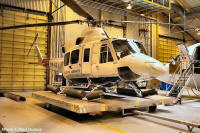
The latest arrival Bell 412HP in the hangar awaiting registration. |
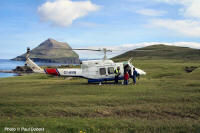
Captain A Mouritsen gives a brief. |
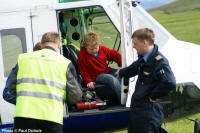
Captain Mouritsen entertaining
a child. |
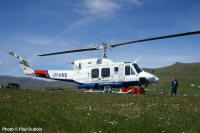
Bell 212 OY-HMB |
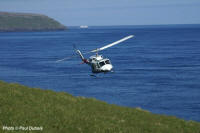
Flying past Hestur. |
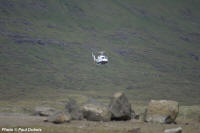
Mountain flying. |
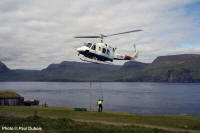
Preparing cattle for hoisting
at Koltur. |
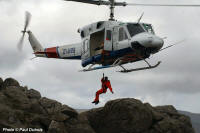
Search and Rescue practice. |
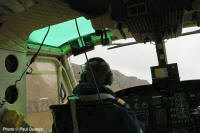
FO Hallur Jensen getting to grips with mountain flying. |
All Photos ©
Paul Dubois
|